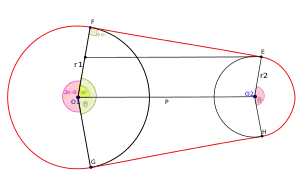Belt problem
The belt problem is a mathematics problem which requires finding the length of a crossed belt that connects two circular pulleys with radius r1 and r2 whose centers are separated by a distance P. The solution of the belt problem requires trigonometry and the concepts of the bitangent line, the vertical angle, and congruent angles.

Solution
Clearly triangles ACO and ADO are congruent right angled triangles, as are triangles BEO and BFO. In addition, triangles ACO and BEO are similar. Therefore angles CAO, DAO, EBO and FBO are all equal. Denoting this angle by (denominated in radians), the length of the belt is
This exploits the convenience of denominating angles in radians that the length of an arc = the radius × the measure of the angle facing the arc.
To find we see from the similarity of triangles ACO and BEO that
For fixed P the length of the belt depends only on the sum of the radius values r1 + r2, and not on their individual values.
Pulley problem

There are other types of problems similar to the belt problem. The pulley problem, as shown, is similar to the belt problem; however, the belt does not cross itself. In the pulley problem the length of the belt is
where r1 represents the radius of the larger pulley, r2 represents the radius of the smaller one, and:
Applications
The belt problem is used [1] in the design of aeroplanes, bicycle gearing, cars, and other items with pulleys or belts that cross each other. The pulley problem is also used in the design of conveyor belts found in airport luggage belts and automated factory lines.[2]
See also
References
- Trigonometry examples in real life Archived April 25, 2009, at the Wayback Machine
- Trigonometry used in conveyor belts Archived February 22, 2012, at the Wayback Machine